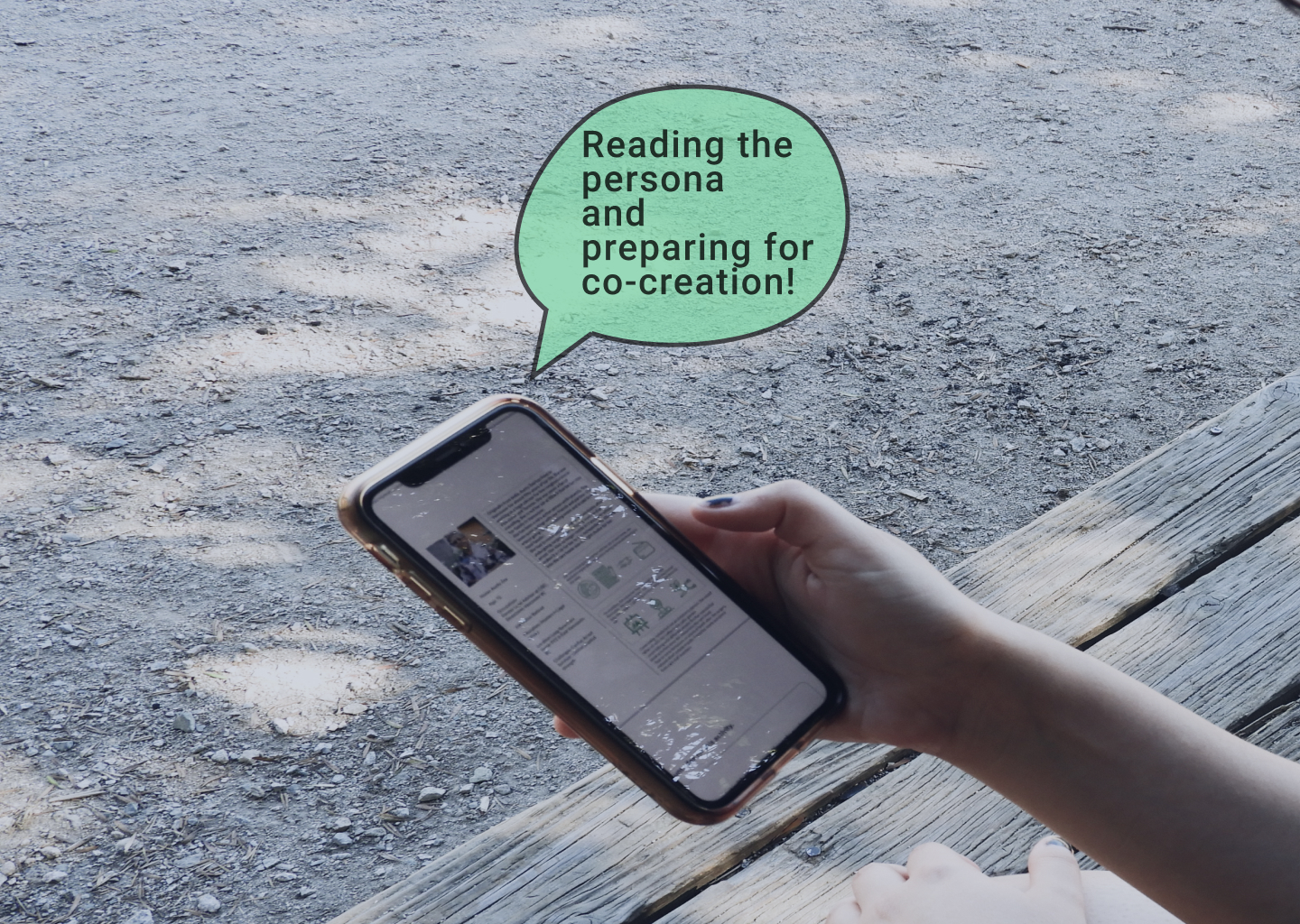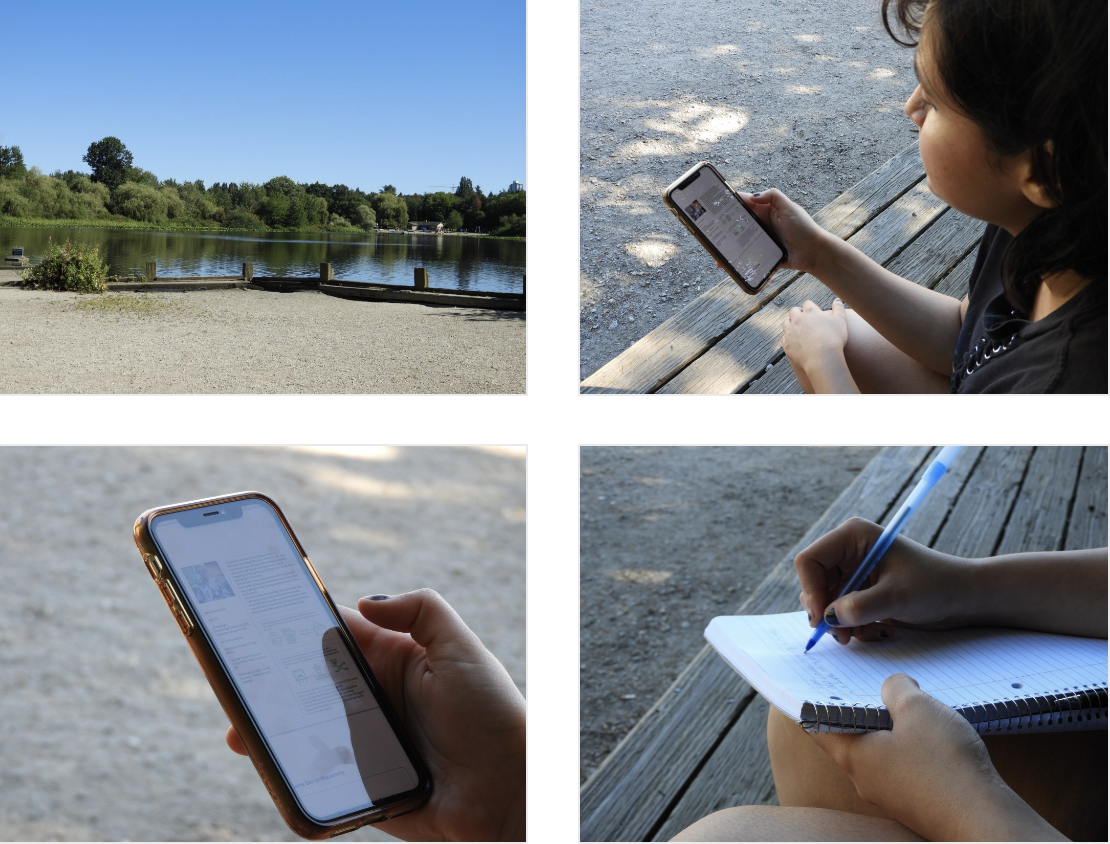Community-Building in Long-Term Care Homes
Investigating ways to build a sense of belongingness and community in long-term care homes leading to the development of the ‘Tree of Care’ a methodology to possibly change the quality of life of seniors.

Project Outline
The research begins with understanding nature, belongingness, and how that affects an individual. It soon turns into an in-depth study about communities and multiculturalism. The analysis then dwelled into its effects on the individuals in a particular setting; in this case, a long-term care home a broad ethnographic spectrum.
As the research unfolds, one can observe a linear trajectory from simple questions like ‘what is a community?’ to complex how-to questions like ‘how might we build a sense of community and belongingness amongst seniors in a multicultural environment of a long-term care home?’ The research then turns into design activities around these questions that lead to a series of senior proxy experiences in outdoor activities to understand our connection to nature and how that invokes a sense of belongingness. The research investigates the system of Dementia Village (De Hogeweyk) in Weesp, Netherlands, through observational mapping and interviews with the staff members. It also explores the care homes in Vancouver, Canada, Mumbai, India and other similar projects.
In conclusion, the research leads to developing a methodology to understand the factors that create a favourable environment for seniors in long-term care homes to establish a community sense. The process, ‘Tree of Care,’ revolves around three main categories based on the previous research. The categories are Acceptance, Open Spaces and Community.
Research Areas
and
Process
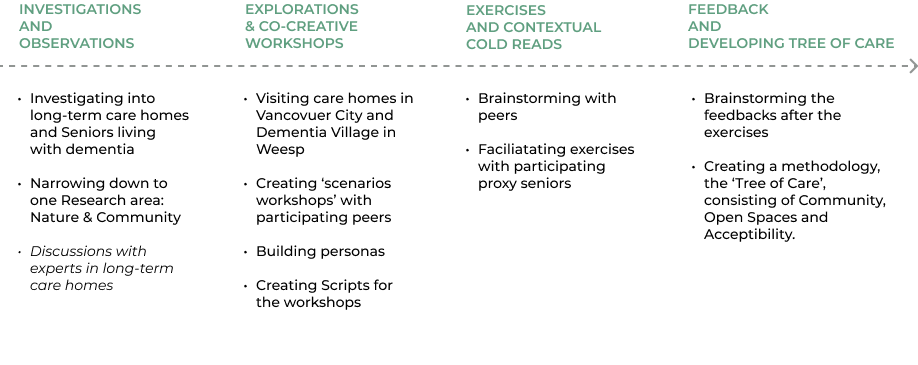
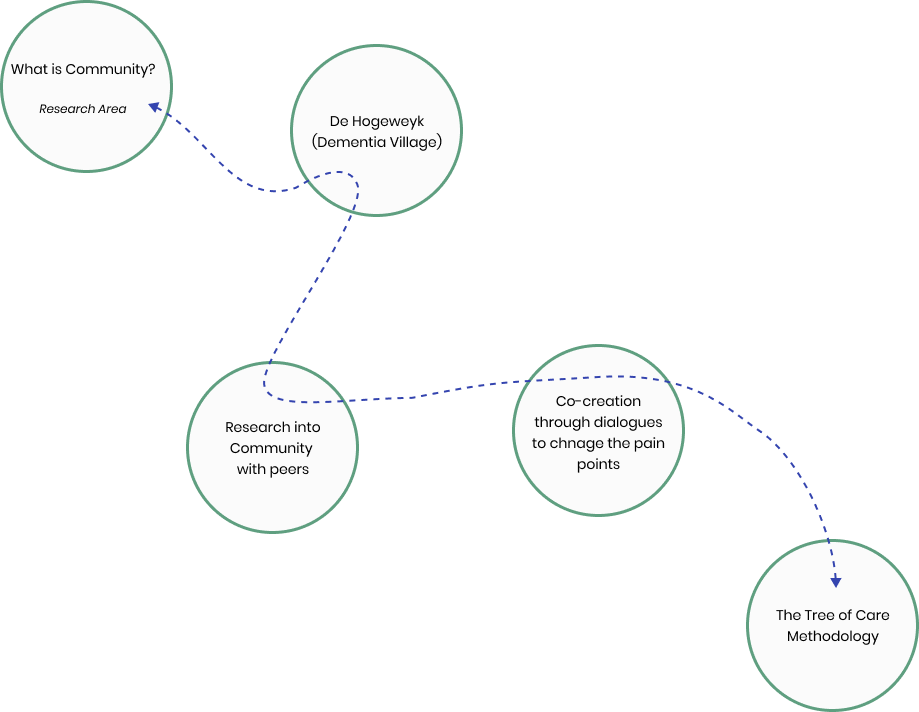
(Diagrammatic Representation of the research process: Set 1 shows the linear process of the research and Set 2 shows the areas of research that were in focus throughout the research)
Community
What is community?
How do you situate yourself in a community?
The first two activities/workshops were based on the broader questions mentioned above.
Leading to follow-up questions and ‘How can nature be used as a tool to engage in community-building in care homes?’
The first activity was more of a conversation opener to understand what people thought a community entails. The activity consisted of distributing the first two questions mentioned above.
That showed an urgent need to explore the development of a community in a space wherein individuals from different cultures inhabit that space together.
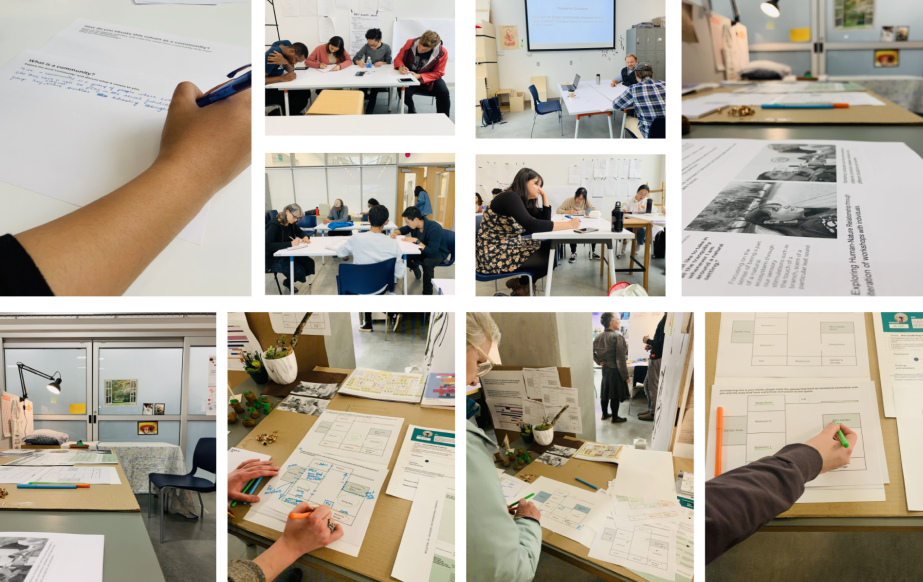
De Hogeweyk
The search then extended to De Hogeweyk (Dementia Village) in Weesp, the Netherlands. The entire structure of the care home was built in a township fashion. It is a care space for seniors living with complex dementia that has been carefully considered. Spaces are designed so that all the lanes, passages, lobbies, garden spaces interconnect. It creates a dynamic platform for residents to interact with their fellow seniors, and care staff are dressed in casual outfits, unlike in conventional care home settings. The result is a nursing home setting that has a village-like feel.
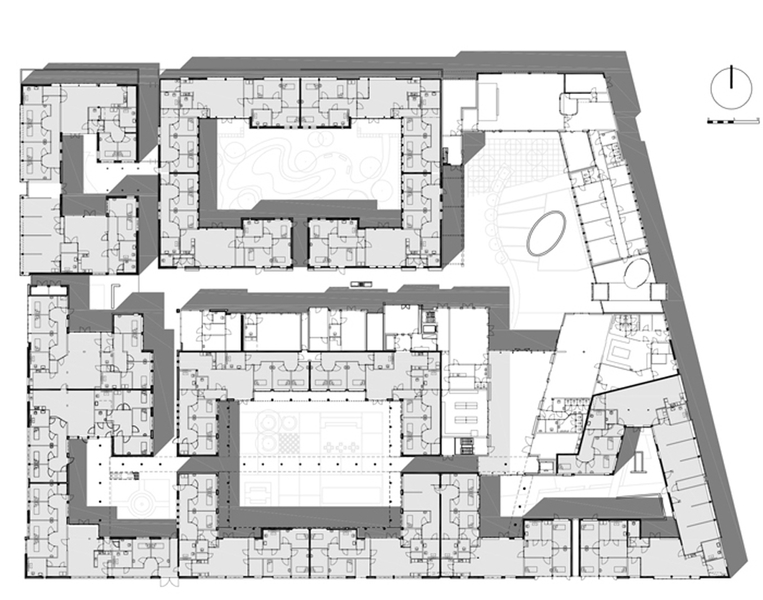
De Hogeweyk is a recognized, innovative, senior healthcare offering. (Larsen D., 2019)
The seniors were open to connecting, comfortable in their new home environment and easily able to do so thanks to their meeting ardour space and being in a situation with new people of the same age and lifestyle.
Interestingly, much of their communication was non-verbal.
Psychologist David Matsumoto, an expert on non-verbal behaviour, culture and emotion, has noted that “the majority of people in the world want to get along. As with all relationships – communication is key. That’s when our non-verbal abilities can help us better relate to other human family members. Even when words fail us.” (Pogosyan, M. Ph.D., 2017[psychologytoday.com])
Despite a considerable rainfall in the Netherlands, the seniors, with their ‘formed’ social circles, also enjoy taking walks and sitting in the open outdoor spaces: near a fountain, in an outdoor cafeteria area, in multiple garden spaces.
This situation enables seniors to easily occupy spaces outside their rooms and houses (ones with selective lifestyles).
Amongst several other seniors that I spent time with, one in particular gave me much pause for thought. One morning, Auntie Helda (pseudonym) sat next to me and talked to me in Dutch.
I attempted to convey that I do not speak or understand Dutch but she continued none the less. All the while she greeted several of her friends strolling in the sun while continuing to talk to me. After a while she left me only to return, take my hand and then seem to indicate “Would you like to walk with me?”
While I could not understand her words, her hand held out, gesturing towards a nearby open lobby letting me know what she wished. We walked, sat down and ‘talked’ more. Well, she talked! I just nodded because even after I told her that I didn’t understand Dutch, she continued speaking with me. It turned into a fun conversation with some gasps when I tried to answer her questions.
In these instances visual cues and gestures are not missed. They become key communicators. I did not understand what Aunt Helda told me, in great detail and with enthusiasm but I still understood her openness, her gestures, smile and was able, in my own way reciprocate!
“A visual-based language can lead to a more universal form of communication, or provide a more coherent approach, thus creating greater chances and facilitating easier integration for individuals in various domains.” (Nawar, H., & Gabr, H., 2013)
That led to the consideration that use of Open Spaces could be a significant site for encouraging community for building meaningful connections for elders.
In the context of health care, service ecosystems are typically comprised of wildly divergent actors, (a person playing a role in the system) including patients and their families and friends, other patients, healthcare professionals, hospitals, health support agencies, professional associations, health insurers, healthcare authorities, government agencies, and regulatory bodies (Frow et al., 2016; Litovuo et al., 2016; Jaakkola, E. et al., 2018). One actor alone cannot maneuver such structures. A dynamic and iterative process involving multiple stakeholders in the ecosystem with varying views on value is needed to maintain or change practices, thereby ultimately institutionalizing innovation (Vargo et al., 2015; Jaakkola, E. et al. et al., 2018). I developed a workshop-led practice for long term care homes, inclusive of the stakeholders mentioned above, to help sustain a sense of community. A vital element of this workshop was a service design layout-mapping exercise to encourage all stakeholders to discuss the care homes’ current scenarios and propose changes by and for the seniors
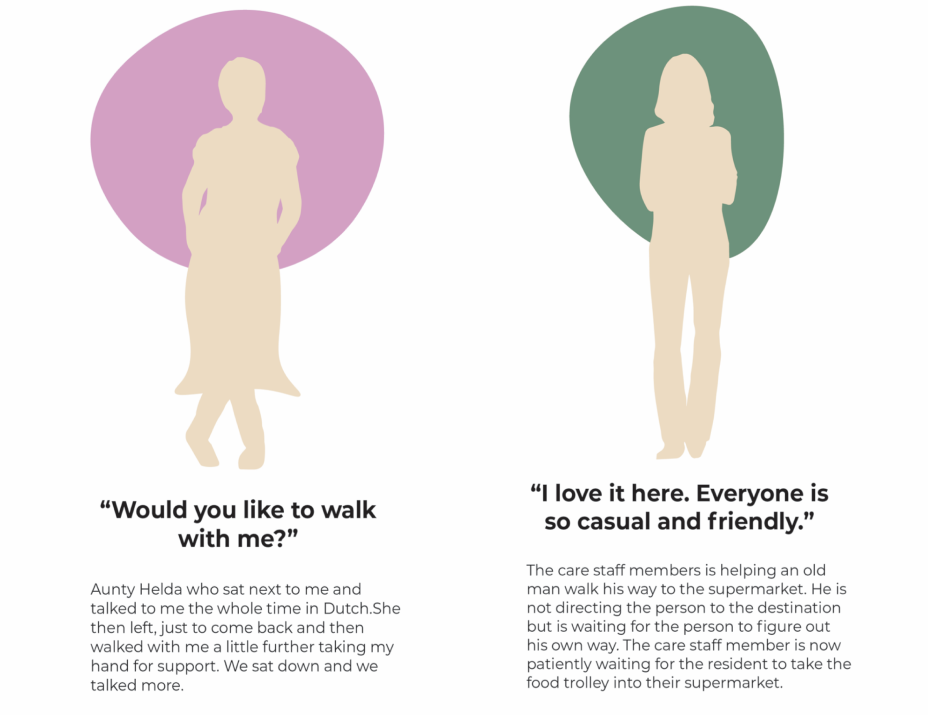
Image Set: Personas of people I observed and interacted with in De Hogeweyk. (Left: Aunty Helda; Right: A care staff member)
Outdoor Walking Exercises
I developed a workshop-led practice for long-term care homes, inclusive of the stakeholders mentioned above, to help sustain a sense of community. This workshop's vital element was a service design layout-mapping exercise to encourage all stakeholders to discuss the care homes' current scenarios and propose changes by and for the seniors.
I based this activity on my observations of the De Hogeweyk’s seniors’ connections to their surrounding space. I wanted to investigate the importance of creating a comfortable surrounding space inside the care home's premises to make seniors sense familiarity and comfort.
In the exercise that I conducted with my peers and a few passersby, I tracked how emotional connections are formed in open spaces. It allowed me to investigate alternate perspectives on creating comfortable and familiar spaces inside care home premises for seniors.
Following are my observations, thoughts and conclusion based on the exercise:
The 'Tree of Care' Methodology
Trees have a special connection with me, from helping me associate myself in new surroundings to bring back nostalgic memories. Memories of time spent in open spaces with my families, trees have been a part of my life experience. Why?
I believe the tree gives you a sense of shelter, protection. Whenever people take refuge underneath a tree, the rain or the harsh sunlight negatively affects them. Trees create a platform for other organisms to create an entire ecosystem around them. Even the interconnectedness of the roots that showcase this beautiful idea that we are interconnected in many ways intrigues me. When I started creating a visual image of the ‘triangle of care,’ I understood how interrelated and co-dependant the three vertices (Acceptance, Open Spaces and Community) are. I started visualizing the trees, the branches and roots acting like veins, connecting every segment together, simply like the observations linking in specific actions.
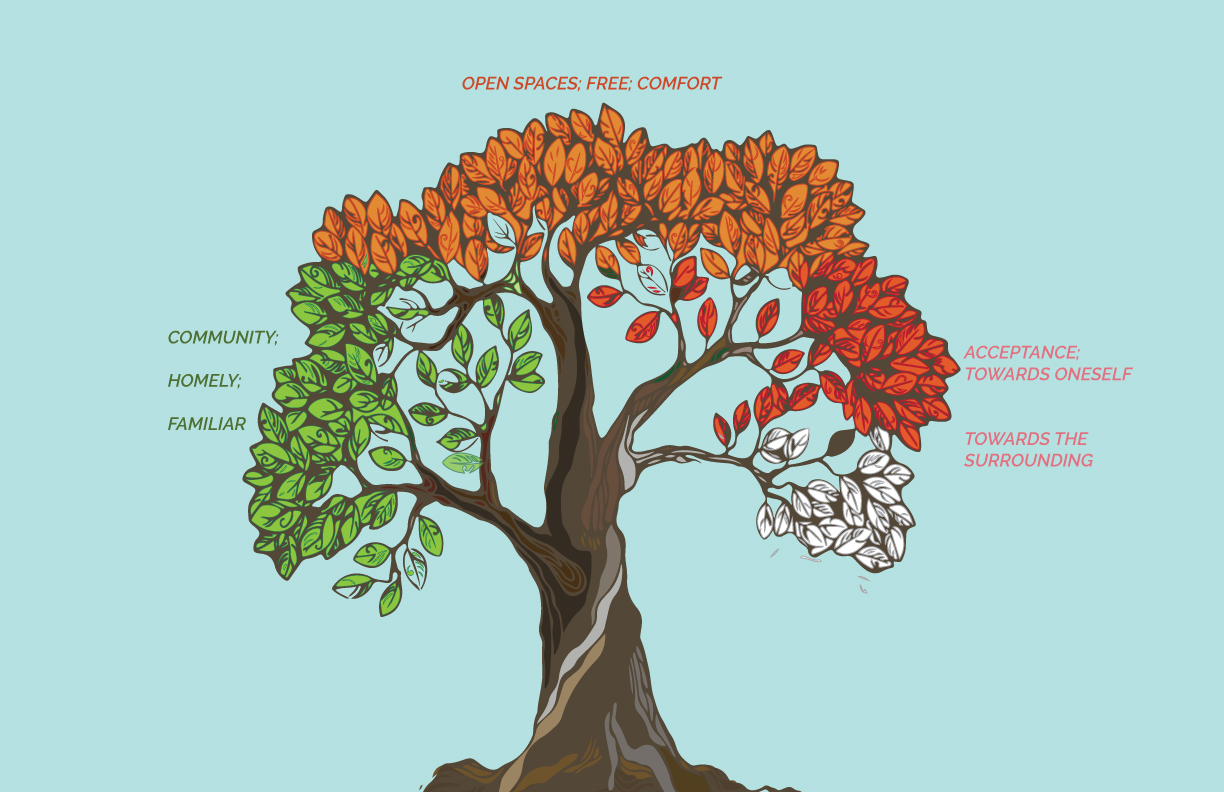
Three Parts of the Tree:
Acceptance: Towards people, towards the surrounding
De Hogeweyk concept branding ‘BE’ promotes the idea of accepting the people/seniors living with dementia as they are to help them be comfortable even when they are losing a part of themselves.
Community:
The idea of belonging to something, something bigger than ourselves. I was looking at nature as a place to belong, however, what I realized is that the people around us help us become familiar to a surrounding; in this case, the care homes.
Open Space:
When you are accepted, you are familiar with the people, where can you be free?
Spaces that are free like your mind and your soul, the open spaces, close to nature where you can be the most unapologetic version of yourself. While acceptance inclines towards accepting change, open spaces impel the idea of being in a surrounding that encourages us to be the most authentic versions of ourselves.
This ‘Tree of Care' made up of Acceptance, Community and Open Spaces was a means for me to understand and consider the differences between an acclaimed ‘successful’ care model like De Hogeweyk and Care Homes in Vancouver while also keeping in mind the cultural and dementia-related differences between these two care home models.
The focus was to analyse the observations and while doing so, the researach took to the discovery of the three primary factors - acceptance in care homes and amongst seniors, the communal feeling and the necessity of open spaces to create the feeling of community and acceptance.
The three branches of the tree are interlinked. I considered the triangular structure to ensure I attend to the three mentioned aspects from a starting point. The tree is a representation of the three different cities that I are the basis of my research. Though separate in geography and culturally different, there were quite some commonalities in these three cities relating to the care home organizations.
Hence the three aspects, Acceptance, Community and Open Space, though separate meet at one point to share all the common factors.
All Projects

KneeHabUser Experience Design, Product Design

Redesigning the Website for an Eye Care ServiceUser Experience Design, Visual Design, HTML, CSS
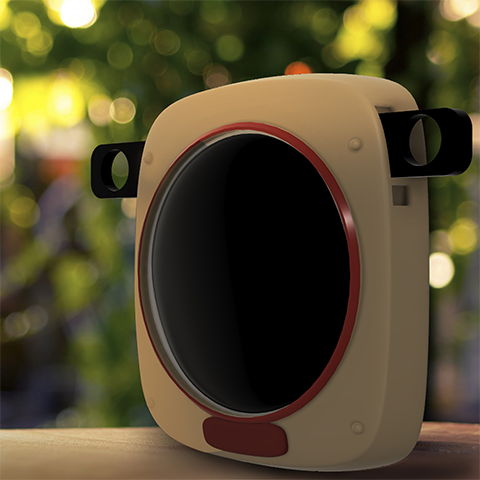
SupportDesign Research, Industrial Design
